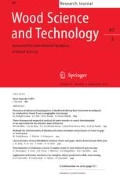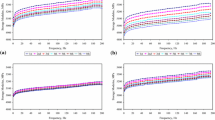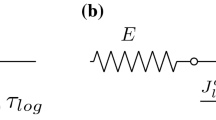Abstract
The viscoelastic properties of the cell wall of the tropic hardwood Carapa procera are investigated by means of nanoindentation tests. Three types of nanoindentation tests are undertaken: creep, continuous stiffness measurement (CSM) and nanoscale dynamic mechanical analysis (Nano-DMA), corresponding to the increased loading rate and so the response of wood cell wall to the loading in a relatively large time scale. It is found that the creep rate is dependent on the applied stress and the relation can be described by the rule of power law. Regarding the dynamic properties (i.e., storage modulus and damping coefficient) in the frequency range of 10–240 Hz, it is shown that the storage modulus increases monotonically, while the damping coefficient decreases. By using the traditional dynamic mechanical thermal analysis as a reference method, the phase transition behavior of wood cell wall can be successfully characterized by the Nano-DMA in a large frequency scale. A dependence of the storage modulus and damping coefficient on the penetration depth is quantified by the CSM tests.










Similar content being viewed by others
References
Asif SAS, Wahl KJ, Colton RJ (1999) Nanoindentation and contact stiffness measurement using force modulation with a capacitive load-displacement transducer. Rev Sci Instrum 70(5):2408–2413
Bower AF, Fleck NA, Needleman A, Ogbonna N (1993) Indentation of a power law creeping solid. Proc Math Phys Sci 441(1911):97–124
Bull SJ (2003) On the origins and mechanisms of the indentation size effect. Z Metallkd 94(7):787–792
Chakravartula A, Komvopoulos K (2006) Viscoelastic properties of polymer surfaces investigated by nanoscale dynamic mechanical analysis. Appl Phys Lett 88:131901
Cheng L, Xia X, Yu W, Scriven LE, Gerberich WW (2000) Flat-punch indentation of viscoelastic material. J Polym Sci Part B 38:10–22
Fischer-Cripps AC (2006) Review of analysis and interpretation of nanoindentation test data. Surf Coat Tech 200(14–15):4153–4165
Furuta Y, Imanishi H, Kohara M, Yokoyama M, Obata Y, Kanayama K (2000) Thermal-softening properties of water-swollen wood (vii) the effects of lignin. Mokuzai Gakkaishi 46(2):133–137
Gindl W, Gupta HS, Schoberl T, Lichtenegger HC, Fratzl P (2004) Mechanical properties of spruce wood cell walls by nanoindentation. Appl Phys A 79(8):2069–2073
Guitard D (1983) The wood materials: properties, technology, processing. Collection of lessons exempted during winter school on woods in Albe (68) from 24 to 29 January 1983, Association for the research on woods in Loraine (Association pour la Recherche sur le Bois en Lorraine (ARBOLOR)), p B1–94
Isaksson H, Nagao S, Malkiewicz M, Julkunen P, Nowak R, Jurvelin JS (2010) Precision of nanoindentation protocols for measurement of viscoelasticity in cortical and trabecular bone. J Biomech 43(12):2410–2417
Kermouche G, Loubet JL, Bergheau JM (2007) Cone indentation of time-dependent materials: the effects of the indentation strain rate. Mech Mater 39(1):24–38
Konnerth J, Gierlinger N, Keckes J, Gindl W (2009) Actual versus apparent within cell wall variability of nanoindentation results from wood cell walls related to cellulose microfibril angle. J Mater Sci 44(16):4399–4406
Lee SH, Wang SQ, Pharr GM (2006) Time-dependent nano-mechanical properties of regenerated cellulose fiber and wood cell wall by continuous nanoindentation technique. Abstracts of Papers of the American Chemical Society, p 231
Liu T (1993) Creep of wood under a large-span of loads in constant and varying environments. Part 1. Experimental-observations and analysis. Holz Roh Werkst 51(6):400–405
Lu H, Wang B, Ma J, Huang G, Viswanathan H (2003) Measurement of creep compliance of solid polymers by nanoindentation. Mech Time-Depend Mater 7(3–4):189–207
Nix WD, Gao HJ (1998) Indentation size effects in crystalline materials: a law for strain gradient plasticity. J Mech Phys Solids 46(3):411–425
Obataya E, Ono T, Norimoto M (2000) Vibrational properties of wood along the grain. J Mater Sci 35(12):2993–3001
Oliver WC, Pharr GM (1992) An improved technique for determining hardness and elastic modulus using load and displacement sensing indentation experiments. J Mater Res 7(6):1564–1583
Saheb DN, Jog JP (1999) Natural fiber polymer composites: a review. Adv Polym Tech 18(4):351–363
Sugiyama M, Norimoto M (1996) Temperature dependence of dynamic viscoelasticities of chemically treated woods. Mokuzai Gakkaishi 42(11):1049–1056
Sugiyama M, Obataya E, Norimoto M (1998) Viscoelastic properties of the matrix substance of chemically treated wood. J Mater Sci 33(14):3505–3510
Tweedie CA, Van Vliet KJ (2006) Contact creep compliance of viscoelastic materials via nanoindentation. J Mater Res 21(6):1576–1589
Tze WTY, Wang S, Rials TG, Pharr GM, Kelley SS (2007) Nanoindentation of wood cell walls: continuous stiffness and hardness measurements. Compos Part A Appl Sci Manuf 38(3):945–953
VanLandingham MR, Villarrubia JS, Guthrie WF, Meyers GF (2001) Nanoindentation of polymers: an overview. Macromol Symp 167:15–43
VanLandingham MR, Chang NK, Drzal PL, White CC, Chang SH (2005) Viscoelastic characterization of polymers using instrumented indentation. I. Quasi-static testing. J Polym Sci B Polym Phys 43(14):1794–1811
White CC, Vanlandingham MR, Drzal PL, Chang NK, Chang SH (2005) Viscoelastic characterization of polymers using instrumented indentation. II. Dynamic testing. J Polym Sci B Polym Phys 43(14):1812–1824
Wimmer R, Lucas BN, Tsui TY, Oliver WC (1997) Longitudinal hardness and young’s modulus of spruce tracheid secondary walls using nanoindentation technique. Wood Sci Technol 31(2):131–141
Zhang YF, Bai SL, Yang DY, Zhang Z, Kao-Walter S (2008) Study on the viscoelastic properties of the epoxy surface by means of nanodynamic mechanical analysis. J Polym Sci B Polym Phys 46(3):281–288
Zhang YF, Bai SL, Li XK, Zhang Z (2009) Viscoelastic properties of nanosilica-filled epoxy composites investigated by dynamic nanoindentation. J Polym Sci B Polym Phys 47(10):1030–1038
Author information
Authors and Affiliations
Corresponding author
Rights and permissions
About this article
Cite this article
Zhang, T., Bai, S.L., Zhang, Y.F. et al. Viscoelastic properties of wood materials characterized by nanoindentation experiments. Wood Sci Technol 46, 1003–1016 (2012). https://doi.org/10.1007/s00226-011-0458-3
Received:
Published:
Issue Date:
DOI: https://doi.org/10.1007/s00226-011-0458-3




